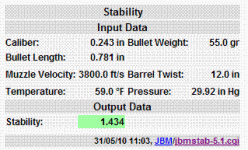shootsteady
Member
Hey all,
this is my first post and I hope you all can help a guy out of this dilemma.
I ran across this website with a twist rate calculator. http://kwk.us/twist.html
The barrel company I bought my varmint barrel from steered me in the wrong direction for bullet selection and admitted it. They refered me to this calculator and hopefully will put me in the ball park as far as the right bullet for 1:12 twist .243 winchester. Before I rebarreled my Savage with thier barrel, I was achieving .75 inch groups at 300 yards with a standard 22"sporter barrel. With thier barrel, I am getting 3 inch groups at 300 yards. At 100 yards things are very good, clover leafing.
I tried 55 to 85 grain bullets with at least 5 diffent powders, all tested at 100 yards for the best groups at different velocities. I read that sometimes a bullet doesn't stabalize until later down range and heard a guy once say that his 22-250 tightens up at 300 yards verses 100 yards.
What say you all?
this is my first post and I hope you all can help a guy out of this dilemma.
I ran across this website with a twist rate calculator. http://kwk.us/twist.html
The barrel company I bought my varmint barrel from steered me in the wrong direction for bullet selection and admitted it. They refered me to this calculator and hopefully will put me in the ball park as far as the right bullet for 1:12 twist .243 winchester. Before I rebarreled my Savage with thier barrel, I was achieving .75 inch groups at 300 yards with a standard 22"sporter barrel. With thier barrel, I am getting 3 inch groups at 300 yards. At 100 yards things are very good, clover leafing.
I tried 55 to 85 grain bullets with at least 5 diffent powders, all tested at 100 yards for the best groups at different velocities. I read that sometimes a bullet doesn't stabalize until later down range and heard a guy once say that his 22-250 tightens up at 300 yards verses 100 yards.
What say you all?


